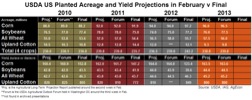- As ever, the week has been interesting, which we seem to report most weeks! We learned many years ago that two days are rarely the same and weeks have a greater tendency towards variation than days, this week being a case in point.
- There has been a marked divergence in price trends between the soybean complex and the grains (corn and wheat) with the former making gains whilst the latter languish at lower levels.
- May ‘13 soybeans in Chicago are now flirting with the $15/bu level, which may well trigger some additional support and buying, pushing the market to higher levels but the initial stimulus for price gains would appear to have emanated from continued strong demand for both beans and products. China continues to source soybeans to lock in their positive crush margins, the EU remains a buyer, and the US domestic crush and demand appears to remain strong. Cash basis remains firm as exporters and crushers alike continue try and squeeze supplies from increasingly strong farm sellers. Little wonder we are beginning to see some upward direction!
 In terms of wheat we remain unconvinced that current price direction is correct! That is not to say we believe the market is wrong, that is never the case, however everything we see from a fundamental perspective appears to point towards bullish tendencies. The old adage that a bull market needs constant feeding may well provide a clue to our current, well-established, trend. We have seen a significant price decline in the last three months, in the order of 20% basis CBOT futures, in the face of adverse weather issues in many producing regions which is reducing output prospects. If we look at the EU end of season stock projections, these are estimated to stand at 20 days usage; not a comfortable situation by any measure. Argentina’s wet weather reduced and damaged crop added to the shortage of supply in Russia and limited Black Sea stocks all add to our fundamental view that prices look cheap right now.
In terms of wheat we remain unconvinced that current price direction is correct! That is not to say we believe the market is wrong, that is never the case, however everything we see from a fundamental perspective appears to point towards bullish tendencies. The old adage that a bull market needs constant feeding may well provide a clue to our current, well-established, trend. We have seen a significant price decline in the last three months, in the order of 20% basis CBOT futures, in the face of adverse weather issues in many producing regions which is reducing output prospects. If we look at the EU end of season stock projections, these are estimated to stand at 20 days usage; not a comfortable situation by any measure. Argentina’s wet weather reduced and damaged crop added to the shortage of supply in Russia and limited Black Sea stocks all add to our fundamental view that prices look cheap right now.
- The one piece of news being traded as far as wheat is concerned right now is the recent heavy snowfall across the US, which is helping to provide much needed moisture across the parched mid-west and plains regions. However, from what we can establish, it would seem unlikely that the damage done to subsoil moisture levels in the last nine months will be fully corrected in time for this season’s crops and their prospects.
- Speculators, in the form of funds, withdrew money from the markets in the run up to the brinkmanship of the US Fiscal Cliff, and have established a large net short position. Last week this stood in excess of 67,500 lots net short, which is some way off their largest net position since the beginning of last year (97,259 net short) but still a big position nonetheless. If for some reason the funds decided that they wished to reverse or significantly reduce their position we could see some potentially large price reaction.
- Corn prices have similarly declined along with wheat and are currently testing level not seen since early January ’13 lows. From a technical perspective, if these lows are breached we could well see further significant decline, which would (as with wheat) fly in the face of fundamentals.
- The USDA Ag Outlook Forum is coming to a close in Washington DC. Crop projections put together by a multitude of USDA agencies are featured and like most years, the Forum projections were bearish for grains. The biggest surprise in their balance sheets for the 2013/14 crop year was only moderately higher corn usage for ethanol. Many analysts are expecting a figure closer to 5 billion bushels of corn for ethanol while the USDA numbers were closer to 4.7 billion. With an abundance of corn from a 14.5+ billion bushel crop, the USDA expects feed usage to rebound to 5.4 billion bushels, a figure not seen since the 2007/08 season. However, at the end of the day, the USDA is still projecting a 2+ billion bushels carryout that is likely to weigh on any new crop rally.

- The next significant event on the reporting calendar will be the release of 1st March stocks, due later in the month, which may well give markets the “shot in the arm” they are looking for; time will, as always, tell.
